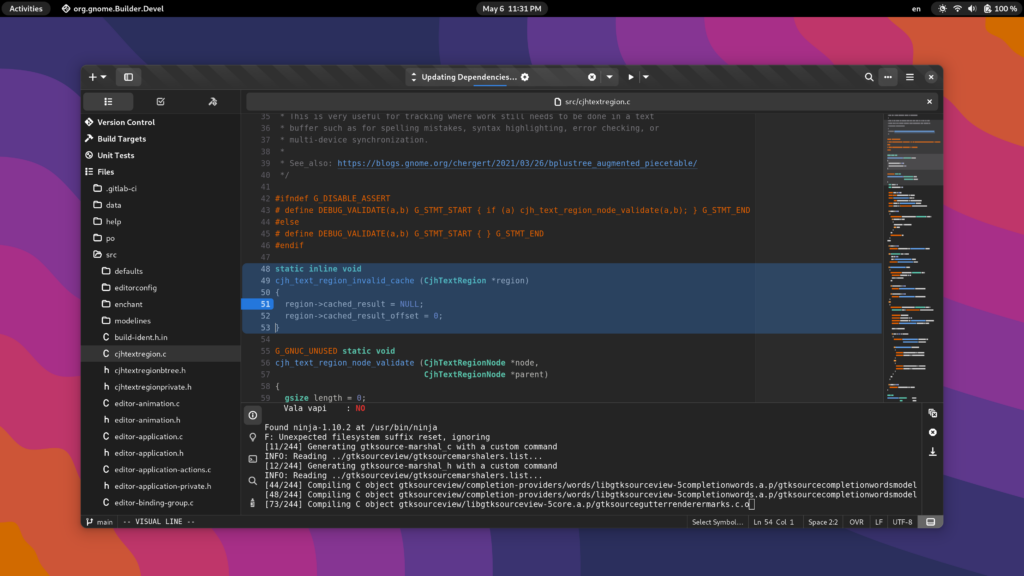Another week of porting Builder which ultimately sent me on a few fun tangents. I especially enjoyed the work on Template-GLib which brought me back to my days working on languages and runtimes.
GTK
- Prototype and submit a merge request to add support for setting an action parent on a widget. This allows you to alter the normal
GtkActionMuxeraction resolution. Very handy for situations like Builder and other document-oriented applications.
GtkSourceView
- GtkSourceView updates to make it possible to write an external “snippet editor” application (Günther is working on one already)
- Improve Solarized style schemes a bit for better IDE integration by specifying colors for
diffas they can be used by git-based gutter renderers. - A little more performance work on gutter renderers as they have always been a major source of runtime costs.
- Allow gutter renderers to overdraw atop the textview so they can do some more fancy things.
VTE
- Figured out why I was getting spinning CPU with the VTE port for GTK 4. Submitted a diagnosis/fix upstream.
Builder
- Prototyped and landed a new shortcut manager with uses a
keybindings.json-like file similar to VS Code (albeit with slightly different syntax which makes more sense for GTK applications). Plugins will be able to override and extend these, as will the user. - Prototyped and landed support for showing “selection area” within the gutter renderer.
- Compress information in a bit tighter space for gutter, as we have a lot of information to display there. Still more we can do should anyone have free time to work on this.
- Improve breakpoints drawing now that we have some overlapping selections to worry about.
- Lots of menu cleanup across plugins.
- More porting from our old
IdeSourceViewinto a new implementation. - Lots of object-lifecycle fixes now that Builder more aggressively shuts down components.
Keybindings look something like this.
I would like to specify how wonderful the new shortcut components are in GTK 4, particularly if you’re writing complex applications that have to manage layered shortcuts, user overrides, and such. I’m thinking applications in the class of Inkscape, GIMP, Builder, Darktable, and such will really benefit from this someday.
Template-GLib
One of the things that Builder needed was the ability to express when a shortcut is active. In VS Code, they have a "when" element which works well enough for this. However, it has some basic expressions that need to be evaluated at runtime.
Builder already has an expression engine which is used for project templates and what not and it even supports GObject Introspection. It was in sore need of some updates but is very capable for the problem here. I have the tendency to only implement enough to solve problems so this was a nice return to finishing some of that up.
One of the nice things here, when the use case is so focused, is that there is no need for a runtime, JIT, etc. It’s just an AST that has a tmpl_expr_eval() API where you pass in scope and all the objects continue to live in C land, nothing special to deal with.
- Add anonymous functions (no lambdas though).
- Allow assigning functions to a symbol.
- Improve function calling under various situations (named, anonymous, and GObject Introspection functions).
- Make constructors work.
- Add a bunch of builtins for things like asserts, casts, math.
- Fix
typeof()builtin for a number of GObject Introspection cases. - Add unit tests!
- Add null keyword.
- You can now do things like
typeof(widget).is_a(typeof(Ide.Page)) - The
require Gtk version "4.0"style imports made it so you couldn’t call.require()due to the Bison parser. That is fixed and you can use@keywordfor reserved keywords. - A
nophas been added with the keywordpass. - Fix a bunch of valgrind discovered things.
- Add linewise comments using the
# python style.
I don’t know how much time I’ll spend on this in the future, or if it will go another few years without much work. But with a maintainer who had time, it could be a nice little glue language without all the “muchness” that more well known languages tend to bring in.
